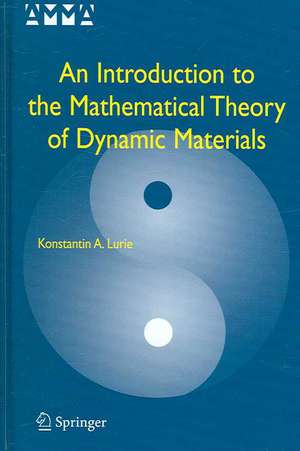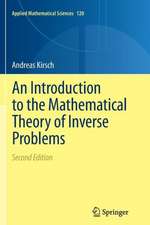An Introduction to the Mathematical Theory of Dynamic Materials: Advances in Mechanics and Mathematics, cartea 15
Autor Konstantin A. Lurieen Limba Engleză Hardback – 24 apr 2007
| Toate formatele și edițiile | Preț | Express |
|---|---|---|
| Paperback (2) | 600.42 lei 38-44 zile | |
| Springer Us – 23 noi 2010 | 600.42 lei 38-44 zile | |
| Springer International Publishing – 25 aug 2018 | 682.56 lei 38-44 zile | |
| Hardback (2) | 641.85 lei 6-8 săpt. | |
| Springer Us – 24 apr 2007 | 641.85 lei 6-8 săpt. | |
| Springer International Publishing – 27 oct 2017 | 787.15 lei 6-8 săpt. |
Din seria Advances in Mechanics and Mathematics
- 24%
 Preț: 782.72 lei
Preț: 782.72 lei - 18%
 Preț: 789.32 lei
Preț: 789.32 lei - 24%
 Preț: 703.36 lei
Preț: 703.36 lei -
 Preț: 395.47 lei
Preț: 395.47 lei - 18%
 Preț: 1006.06 lei
Preț: 1006.06 lei - 18%
 Preț: 1011.27 lei
Preț: 1011.27 lei - 15%
 Preț: 699.96 lei
Preț: 699.96 lei - 18%
 Preț: 951.91 lei
Preț: 951.91 lei - 18%
 Preț: 1388.36 lei
Preț: 1388.36 lei - 15%
 Preț: 649.54 lei
Preț: 649.54 lei - 18%
 Preț: 1224.68 lei
Preț: 1224.68 lei - 18%
 Preț: 1670.41 lei
Preț: 1670.41 lei - 15%
 Preț: 648.89 lei
Preț: 648.89 lei - 15%
 Preț: 695.01 lei
Preț: 695.01 lei - 18%
 Preț: 962.81 lei
Preț: 962.81 lei - 15%
 Preț: 642.51 lei
Preț: 642.51 lei - 18%
 Preț: 968.82 lei
Preț: 968.82 lei - 18%
 Preț: 947.50 lei
Preț: 947.50 lei -
 Preț: 400.85 lei
Preț: 400.85 lei - 20%
 Preț: 559.21 lei
Preț: 559.21 lei - 20%
 Preț: 561.12 lei
Preț: 561.12 lei - 15%
 Preț: 644.18 lei
Preț: 644.18 lei - 24%
 Preț: 790.73 lei
Preț: 790.73 lei - 18%
 Preț: 965.52 lei
Preț: 965.52 lei - 15%
 Preț: 648.24 lei
Preț: 648.24 lei
Preț: 641.85 lei
Preț vechi: 755.13 lei
-15% Nou
Puncte Express: 963
Preț estimativ în valută:
122.83€ • 127.77$ • 101.41£
122.83€ • 127.77$ • 101.41£
Carte tipărită la comandă
Livrare economică 14-28 aprilie
Preluare comenzi: 021 569.72.76
Specificații
ISBN-13: 9780387382784
ISBN-10: 038738278X
Pagini: 182
Ilustrații: XVIII, 182 p.
Dimensiuni: 155 x 235 x 13 mm
Greutate: 0.46 kg
Ediția:2007
Editura: Springer Us
Colecția Springer
Seria Advances in Mechanics and Mathematics
Locul publicării:New York, NY, United States
ISBN-10: 038738278X
Pagini: 182
Ilustrații: XVIII, 182 p.
Dimensiuni: 155 x 235 x 13 mm
Greutate: 0.46 kg
Ediția:2007
Editura: Springer Us
Colecția Springer
Seria Advances in Mechanics and Mathematics
Locul publicării:New York, NY, United States
Public țintă
ResearchCuprins
A General Concept of Dynamic Materials.- An Activated Elastic Bar: Effective Properties.- Dynamic Materials in Electrodynamics of Moving Dielectrics.- G-closures of a Set of Isotropic Dielectrics with Respect to One-Dimensional Wave Propagation.- Rectangular Microstructures in Space-Time.- Some Applications of Dynamic Materials in Electrical Engineering and Optimal Design.
Recenzii
This book is the first monograph presenting an explicit account of a new material concept: it introduces and explores formations with parameters variable in both space and time and therefore called dynamic materials (DM). Being thermodynamically open systems, DM may be adjusted to a dynamic environment due to unusual effects produced by their mass/momentum/energy exchange with the environment. A number of such effects forms a basis for technical devices that support energy accumulation and its storage in traveling waves, effective sensing, isolation of extended domains in space-time from the invasion of dynamic disturbances, etc. The DM concept is at the same time theoretically significant as the means of material optimization and design in dynamics based on the ideas conceptually different from those traditionally applicable in statics, such as homogenization. All in all, the book by Lurie represents a fundamental work that will become a source of novel conceptual ideas and engineering applications. (Iliya I. Blekhman, Materials Physics and Mechanics 11 (2011), pp. 190-193)
Textul de pe ultima copertă
This book gives a mathematical treatment of a novel concept in material science that characterizes the properties of dynamic materials—that is, material substances whose properties are variable in space and time. Unlike conventional composites that are often found in nature, dynamic materials are mostly the products of modern technology developed to maintain the most effective control over dynamic processes. These materials have diverse applications: tunable left-handed dielectrics, optical pumping with high-energy pulse compression, and electromagnetic stealth technology, to name a few. Of special significance is the participation of dynamic materials in almost every optimal material design in dynamics.
The book discusses some general features of dynamic materials as thermodynamically open systems; it gives their adequate tensor description in the context of Maxwell’s theory of moving dielectrics and makes a special emphasis on the theoreticalanalysis of spatio-temporal material composites (such as laminates and checkerboard structures). Some unusual applications are listed along with the discussion of some typical optimization problems in space-time via dynamic materials.
Audience
This book is intended for applied mathematicians interested in optimal problems of material design for systems governed by hyperbolic differential equations. It will also be useful for researchers in the field of smart metamaterials and their applications to optimal material design in dynamics.
The book discusses some general features of dynamic materials as thermodynamically open systems; it gives their adequate tensor description in the context of Maxwell’s theory of moving dielectrics and makes a special emphasis on the theoreticalanalysis of spatio-temporal material composites (such as laminates and checkerboard structures). Some unusual applications are listed along with the discussion of some typical optimization problems in space-time via dynamic materials.
Audience
This book is intended for applied mathematicians interested in optimal problems of material design for systems governed by hyperbolic differential equations. It will also be useful for researchers in the field of smart metamaterials and their applications to optimal material design in dynamics.
Caracteristici
Novel exposition of new mathematical theory developed by the author
Descriere
Descriere de la o altă ediție sau format:
This book has emerged from the study of a new concept in material science that has been realized about a decade ago. Before that, I had been working for more than 20 years on conventional composites assembled in space and therefore adjusted to optimal material design in statics. The reason for that adjustmentisthatsuchcompositesappearedtobecomenecessaryparticipants in almost any optimal material design related to a state of equilibrium. A theoretical study of conventional composites has been very extensive over a long period of time. It received stimulation through many engineering applications, and some of the results have become a part of modern industrial technology. But again, the ordinary composites are all about statics, or, at the utmost, are related to control over the free vibration modes, a situation conceptually close to a static equilibrium. The world of dynamics appears to be quite di?erent in this aspect. When it comes to motion, the immovable material formations distributed in space alone become insu?cient as the elements of design because they are incapable of getting fully adjusted to the temporal variation in the environment. To be able to adequately handle dynamics, especially the wave motion, the material medium must itself be time dependent, i.e. its material properties should vary in space and time alike. Any substance demonstrating such variation has been termed a dynamic material [1].
This book has emerged from the study of a new concept in material science that has been realized about a decade ago. Before that, I had been working for more than 20 years on conventional composites assembled in space and therefore adjusted to optimal material design in statics. The reason for that adjustmentisthatsuchcompositesappearedtobecomenecessaryparticipants in almost any optimal material design related to a state of equilibrium. A theoretical study of conventional composites has been very extensive over a long period of time. It received stimulation through many engineering applications, and some of the results have become a part of modern industrial technology. But again, the ordinary composites are all about statics, or, at the utmost, are related to control over the free vibration modes, a situation conceptually close to a static equilibrium. The world of dynamics appears to be quite di?erent in this aspect. When it comes to motion, the immovable material formations distributed in space alone become insu?cient as the elements of design because they are incapable of getting fully adjusted to the temporal variation in the environment. To be able to adequately handle dynamics, especially the wave motion, the material medium must itself be time dependent, i.e. its material properties should vary in space and time alike. Any substance demonstrating such variation has been termed a dynamic material [1].













